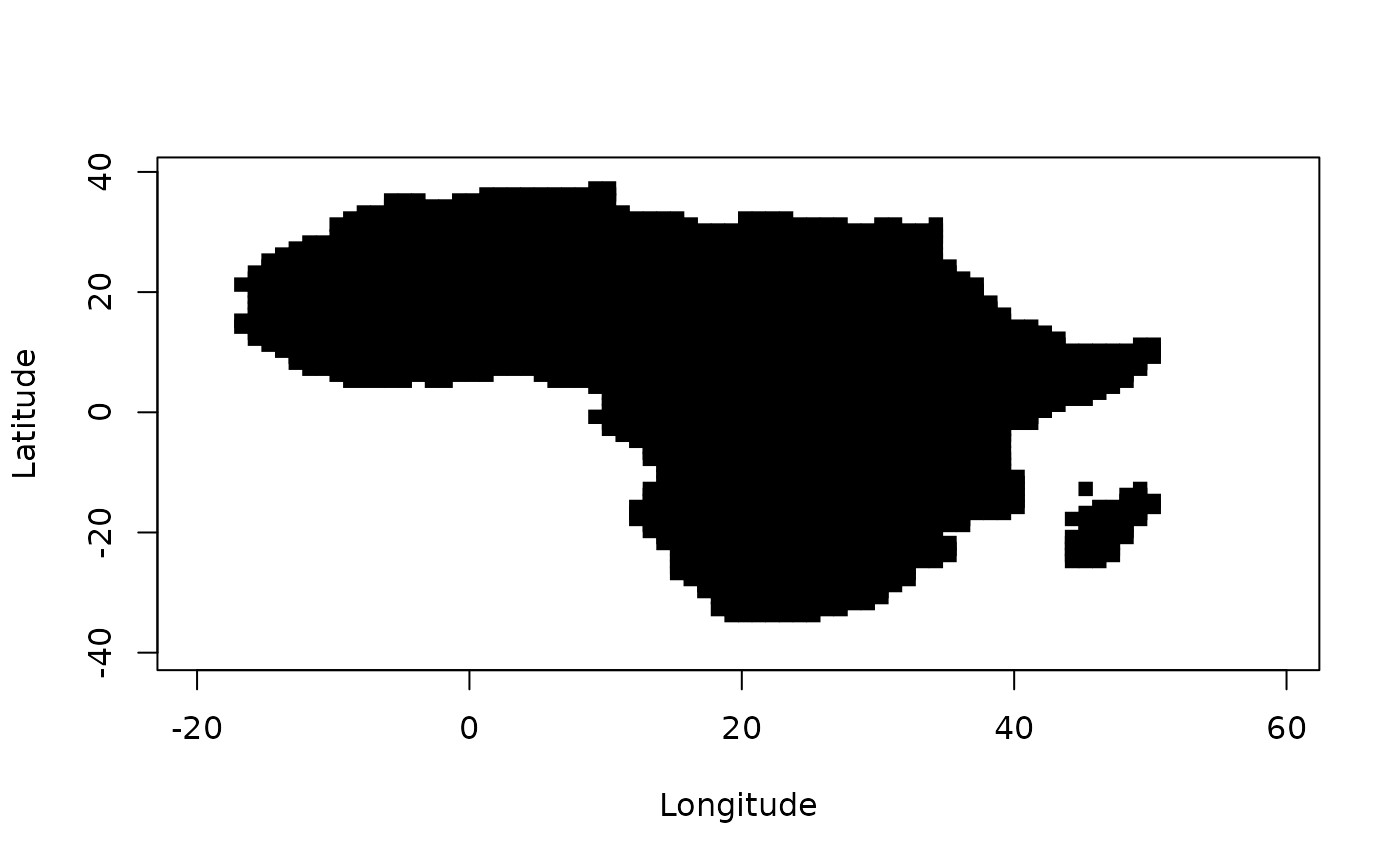Geographic mask from longitude and latitude
geogMask.RdgeogMask is a helper function that preprocess input for the
HiClimR via geogMask parameter.
Usage
geogMask(continent = NULL, region = NULL, country = NULL, lon = NULL, lat = NULL,
InDispute = TRUE, verbose = TRUE, plot = FALSE, colPalette = NULL, pch = 15, cex = 1)Arguments
- continent
NULLor a string (or array of strings) to specifycontinentname(s): only one ofcontinent,region, orcountryshould be specified. Valid list ofcontinentnames can be obtained by runninggeogMask().- region
NULLor a string (or array of strings) to specifyregionname(s): only one ofcontinent,region, orcountryshould be specified. Valid list ofregionnames can be obtained by runninggeogMask().- country
NULLor a string (or array of strings) to specifycountryISO3 character code(s): only one ofcontinent,region, orcountryshould be specified. Valid list ofcountryISO3 character code(s) can be obtained by runninggeogMask().- lon
a vector of longitudes with length
N. Longitudes takes values from-180to180(not0to360). For gridded data, the length may have the value (n) provided thatn * m = Nwheren = length(unique(lon))andm = length(unique(lat)).- lat
a vector of latitudes with length
Norm. Seelon.- InDispute
a logical: should the areas in dispute be considered for geographic masking by country? If
InDispute = TRUE(the default), areas in dispute will be considered as a part of thecountry.- verbose
logical to print processing information if
verbose = TRUE.- plot
logical to call the plotting method if
plot = TRUE.- colPalette
a color palette or a list of colors such as that generated by
rainbow,heat.colors,topo.colors,terrain.colorsor similar functions.- pch
Either an integer specifying a symbol or a single character to be used as the default in plotting points. See
pointsfor possible values.- cex
A numerical value giving the amount by which plotting symbols should be magnified relative to the
default = 1.
Value
A vector of indices for the spatial elements to be masked,
as required by HiClimR.
Details
In some applications, a user may want to focus on an area that is a
mask-defined subset of the full dataset. For instance, the NASA Tropical
Rainfall Measuring Mission (TRMM) data covers ocean and land, while a
researcher might be interested in the precipitation variability only over
land, a country, or a list of countries (e.g., Nile Basin countries). This
masking capability is supported by the geogMask helper function.
It requires the longitude (lon) and latitude (lat) vectors
together with a string (or array of strings) to specify continent
name(s), region name(s), or country ISO3 character code(s) via
either continent, region, or country parameters. Valid
values for them can be obtained by running geogMask(). World mask data
is based on the HIU Large Scale International Boundaries (LSIB) data
(https://hiu.state.gov/data).
References
Hamada S. Badr, Zaitchik, B. F. and Dezfuli, A. K. (2015): A Tool for Hierarchical Climate Regionalization, Earth Science Informatics, 8(4), 949-958, doi:10.1007/s12145-015-0221-7 .
Hamada S. Badr, Zaitchik, B. F. and Dezfuli, A. K. (2014): Hierarchical Climate Regionalization, Comprehensive R Archive Network (CRAN), https://cran.r-project.org/package=HiClimR.
Author
Hamada S. Badr <badr@jhu.edu>, Benjamin F. Zaitchik <zaitchik@jhu.edu>, and Amin K. Dezfuli <amin.dezfuli@nasa.gov>.
See also
HiClimR, HiClimR2nc, validClimR,
geogMask, coarseR, fastCor,
grid2D and minSigCor.
Examples
require(HiClimR)
## Load test case data
x <- TestCase$x
## Generate longitude and latitude mesh vectors
xGrid <- grid2D(lon = unique(TestCase$lon), lat = unique(TestCase$lat))
lon <- c(xGrid$lon)
lat <- c(xGrid$lat)
## Check the valid options for geographic masking
geogMask()
#> ---> Checking geographic masking options...
#> $continent
#> [1] "Africa" "Americas" "Antarctica" "Asia" "Europe"
#> [6] "Oceania"
#>
#> $region
#> [1] "Antarctica" "Australia and New Zealand"
#> [3] "Caribbean" "Central America"
#> [5] "Central Asia" "Eastern Africa"
#> [7] "Eastern Asia" "Eastern Europe"
#> [9] "Melanesia" "Micronesia"
#> [11] "Middle Africa" "Northern Africa"
#> [13] "Northern America " "Northern Europe"
#> [15] "Polynesia" "South America"
#> [17] "South-Eastern Asia" "Southern Africa"
#> [19] "Southern Asia" "Southern Europe"
#> [21] "Western Africa" "Western Asia"
#> [23] "Western Europe"
#>
#> $country
#> [1] "ABW" "AFG" "AGO" "AIA" "ALB" "AND" "ANT" "ARE" "ARG" "ARM" "ASM" "ATA"
#> [13] "ATF" "ATG" "AUS" "AUT" "AZE" "BDI" "BEL" "BEN" "BFA" "BGD" "BGR" "BHR"
#> [25] "BHS" "BIH" "BLM" "BLR" "BLZ" "BMU" "BOL" "BRA" "BRB" "BRN" "BTN" "BVT"
#> [37] "BWA" "CAF" "CAN" "CCK" "CHE" "CHL" "CHN" "CIV" "CMR" "COD" "COG" "COK"
#> [49] "COL" "COM" "CPV" "CRI" "CUB" "CUW" "CXR" "CYM" "CYP" "CZE" "DEU" "DJI"
#> [61] "DMA" "DNK" "DOM" "DZA" "ECU" "EGY" "ERI" "ESH" "ESP" "EST" "ETH" "FIN"
#> [73] "FJI" "FLK" "FRA" "FRO" "FSM" "GAB" "GBR" "GEO" "GGY" "GHA" "GIN" "GLP"
#> [85] "GMB" "GNB" "GNQ" "GRC" "GRD" "GRL" "GTM" "GUF" "GUM" "GUY" "HKG" "HMD"
#> [97] "HND" "HRV" "HTI" "HUN" "IDN" "IMN" "IND" "IOT" "IRL" "IRN" "IRQ" "ISL"
#> [109] "ISR" "ITA" "JAM" "JEY" "JOR" "JPN" "KAZ" "KEN" "KGZ" "KHM" "KIR" "KNA"
#> [121] "KOR" "KWT" "LAO" "LBN" "LBR" "LBY" "LCA" "LIE" "LKA" "LSO" "LTU" "LUX"
#> [133] "LVA" "MAC" "MAF" "MAR" "MCO" "MDA" "MDG" "MDV" "MEX" "MHL" "MKD" "MLI"
#> [145] "MLT" "MMR" "MNE" "MNG" "MNP" "MOZ" "MRT" "MSR" "MTQ" "MUS" "MWI" "MYS"
#> [157] "MYT" "NAM" "NCL" "NER" "NFK" "NGA" "NIC" "NIU" "NLD" "NOR" "NPL" "NRU"
#> [169] "NZL" "OMN" "PAK" "PAN" "PCN" "PER" "PHL" "PLW" "PNG" "POL" "PRI" "PRK"
#> [181] "PRT" "PRY" "PSE" "PYF" "QAT" "REU" "ROU" "RUS" "RWA" "SAU" "SDN" "SEN"
#> [193] "SGP" "SGS" "SHN" "SJM" "SLB" "SLE" "SLV" "SMR" "SOM" "SPM" "SSD" "STP"
#> [205] "SUR" "SVK" "SVN" "SWE" "SWZ" "SXM" "SYC" "SYR" "TCA" "TCD" "TGO" "THA"
#> [217] "TJK" "TKL" "TKM" "TLS" "TON" "TTO" "TUN" "TUR" "TUV" "TWN" "TZA" "UGA"
#> [229] "UKR" "UMI" "URY" "USA" "UZB" "VAT" "VCT" "VEN" "VGB" "VIR" "VNM" "VUT"
#> [241] "WLF" "WSM" "YEM" "ZAF" "ZMB" "ZWE"
#>
## geographic mask for Africa
gMask <- geogMask(continent = "Africa", lon = lon, lat = lat, plot = TRUE)
#> ---> Checking geographic masking options...
#> ---> Checking geographic masking data...
#> ---> Geographic masking by continent...
#> ---> Generating geographic mask map...
